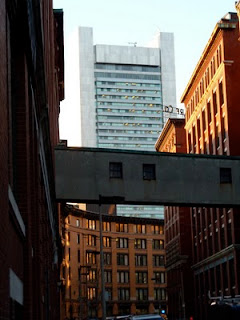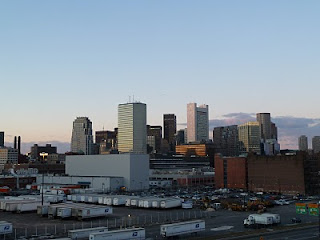As reported in
this story via Media Bistro's Unbiege, the
Chicago Spire is officially, actually, really, dead. Also, not going to happen.
Ever, as some say. Literally. Its a sad moment in Chicago's, and the country's, celebrated history of boldly erecting the world's tallest buildings (at least in our own cities.
The Burj Khalifa is undeniably
a Chicago building, albeit on the other side of the globe, but more on the similarities to Dubai a bit further on).
Chicago World Trade Center, c.1980.
Harry Weese & Assoc.
7 South Dearborn, a 2,000ft. super-antennae,
a stayed mast with office/residential almost an afterthought.
c.2000 ©Skimore Owings Merrill
By the way, yes, I know that Chicago's tallest building has a new name, and a sarcastic pat on the back to the first Wikipedian who rushed to rename the Sears Tower entry. It is dumb and hubristic to rename such an icon and I am personally ignoring this new appellation, as I would if an investor bought the Wrigley Building, the Chrysler Building, the John Hancock, or the Empire State Building and tried to rename those.
Come to think on it, maybe the renaming of the Sears is another telling sign in the city hurtling away from the Era of Big, that proud era when it boasted the world's largest building, tallest building, busiest airport, biggest commodities exchange, etc. None of which is true anymore, and many of these titles have been transferred to Asia. Chicago was fading.
But then there was to be a renaissance. The Chicago Boards were on the cutting edge of technology, merging and creating a Credit Default Swap Clearinghouse-- how brilliant and bold and modern! O'Hare was so busy they had to restrict flight movements, that's the only reason why it wasn't still the world's busiest. And people were moving downtown. And not just into boring glass-and-concrete high-rises, although there were dozens of those. For Chicago, there was to be something bigger and bolder. How about taking the world's tallest title back?
An early Spire advert, when backed by Fordham. c.2006
There was an enormous sense of anticipation and excitement around the Spire when it was announced and marketed. During this time, I happened to be living in Streeterville, the River- and Lakeside neighborhood where the Spire was to rise. Out of my window every day I could see empty blue sky where soon thousands of feet of building would stand.
View of the Spire site when active taken from a McClurg Ct. apartment ©2008 Bauzeitgeist.
The entire United States, and really the entire globe, was experiencing the headiness of real-estate rush during these years, from cottages in County Cork to Cape Cods in California. But the Spire was part of that particularly glossy, urban and urbane ultra-luxury residential property dream that arced across the globe from the Gulf to the West End, in the previously 9-to5 only major American downtowns and in the boom cities of Asia. This became even more so when Calatrava's design, his vision, became the selling mythology of the project, with media adverts in European and American magazines.
Heavy on the Calatrava, from the Financial Times, c.2008
Around the Spire site itself, the few blocks of
southern Streeterville between the Northwestern Hospital and the Chicago River was from 2006 until 2009 nearly something like a mini-Dubai: There was so much active construction, with cranes spinning over the streets, day-by-day, floor-by-floor blotting out the blue of the sky and the green of the lake.


The Streeter, eventually blotting out part of the view of the lake.
©2008 Bauzeitgeist


The Trump Chicago, now Chicago's 2nd tallest,
and the highest built since the 1970s.
©2008 Bauzeitgeist
But there was the more cerebral or perhaps emotional
the fever of the future, with every block a proposed site or a makeshift condo-sales office. Journalists referred to
landmarks that had yet to move off the drawings; neighbors gave street directions mentioning places that were still just piles of earth. No matter, it was coming, and endless procession of Newness coming online next year and for years after that. Were you going? Where are you buying? WHO ware you living?
Helmut Jahn, how very sleek.
Trump, well that will be nice, I'm sure.
Calatrava, oh, dead cool.

The model in the sales office of a development on Illinois.
The only tower to be built was the one I lived in.
©2008 Bauzeitgeist

Image courtesy of Dantheman. Spire at left, Waldorf at center.

Image courtesy of Dantheman. Spire at background, Waldorf colored tower.

Showing The 1,215ft. Waldorf from the boat basin, looking west.
But then it was all over. It was nothing. The sales offices closed, the vacant lots were cleared of equipment. It was quiet. There was just the ground, the lake, and the sky.































